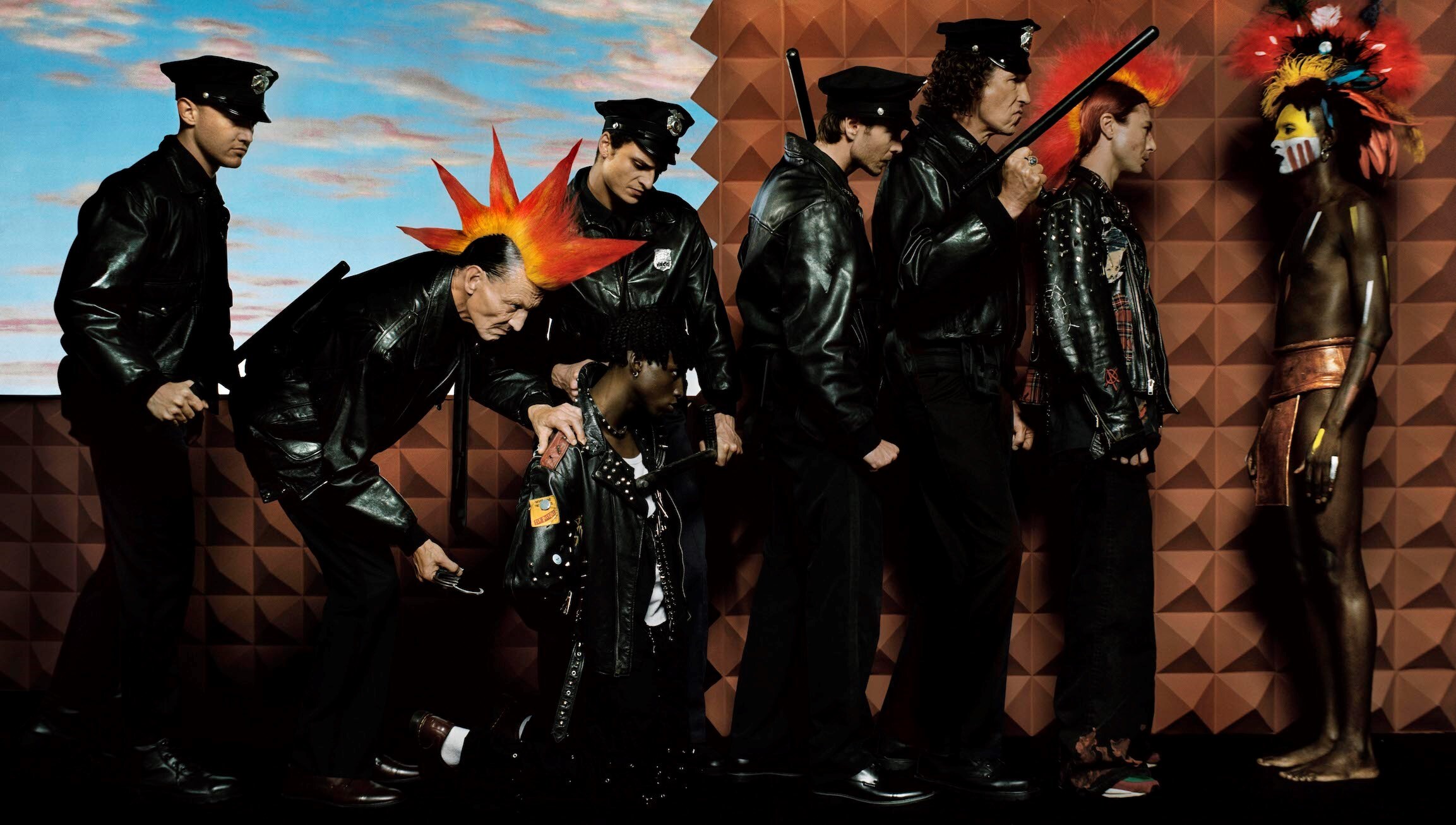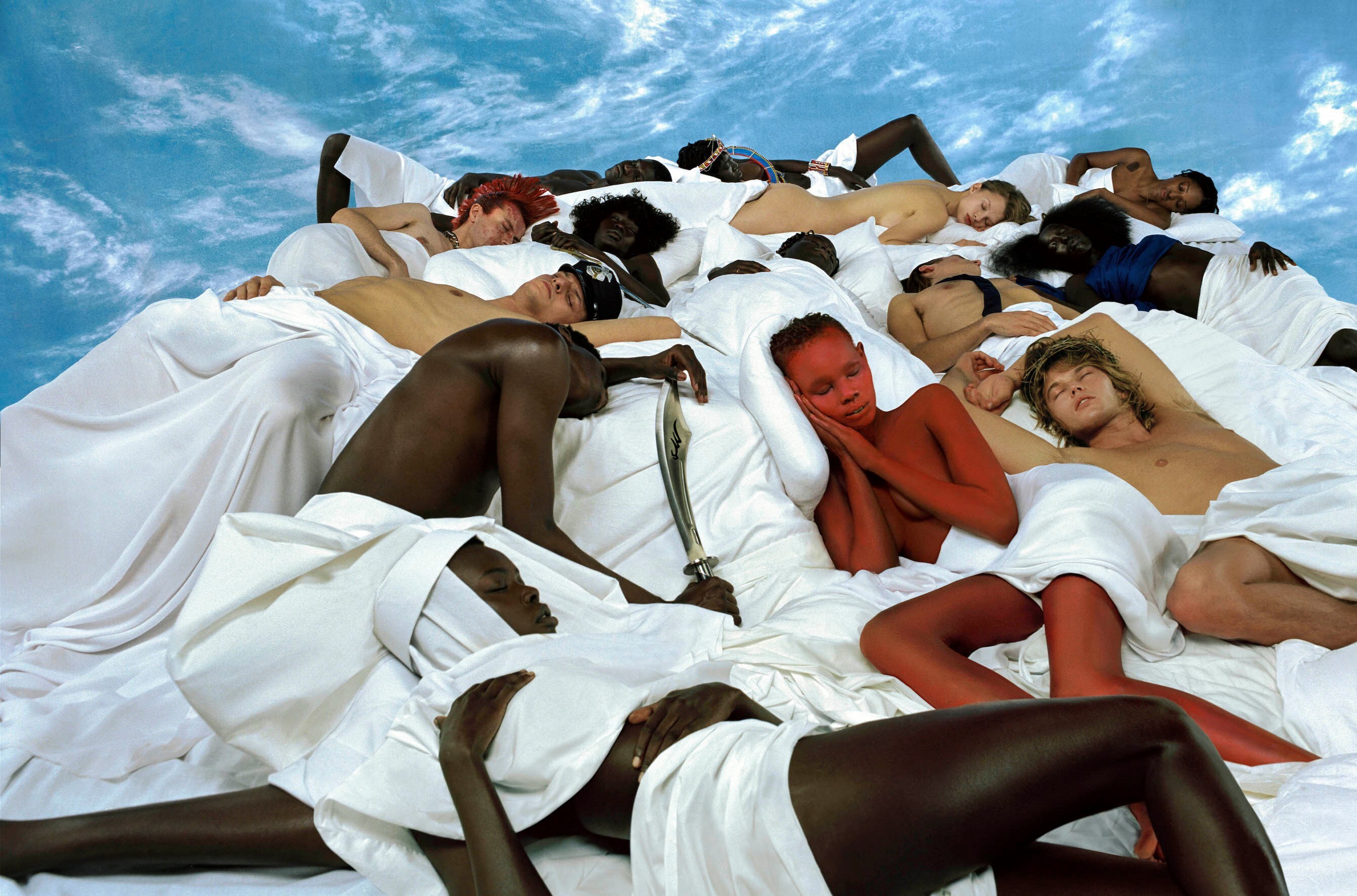How do images create, enforce or alter our beliefs? That’s the question at the centre of photographer Hugo Comte and Dazed editor-in-chief and stylist IB Kamara’s new artistic collaboration and exhibition, Testament.
Riffing off and reappropriating religious iconography, pop culture symbols, and mythology, Comte and Kamara have scripted an alternative history. In this monumental and cinematic series of works that includes the takedown of white Jesus, followed by an image of a Black female Jesus, a white punk policeman arresting a Black punk and a tribesman, among others, the photographer and stylist ask us to question what we believe. In their eyes, if these images were presented hundreds of years ago, they could have changed the trajectory of the way we see the world. Because why is it not possible that Jesus was a Black woman? In Comte and Kamara’s Testament, it’s not simply possible – it’s gospel.
Alongside the physical exhibition, Comte plans to launch it in a virtual gallery in the next few weeks. Ahead of its opening, we caught up with the pair ahead of the show’s opening.

Ashleigh Kane: Congratulations on the opening. How did Testament come about?
Hugo Comte: It was initially very abstract, conceptual, and intentional. Then when Ibrahim and I met, he had a very specific vision, and started to create storytelling and narrative around that abstract part.
IB Kamara: I love the way you and I work together. It was like being in university again because you brought so many references. It inspired so many conversations in my head, and then we spoke more and realised how much we had in common that it all just made sense to tell this story.
AK: Tell us about some of the references that hold Testament together.
IK: The common thread is about looking at society and questioning certain things, shedding light on things, flipping things upside down. It’s juxtaposing and rewriting history or questioning it. There are a lot of questions in the work, and there are new ideas that we’re proposing.
“In the defeat of the white Jesus, it’s a revolt against white religious figures spreading Christianity through Africa. We bring a positive answer in another image of Black Jesus, a female Jesus with an afro” – Hugo Comte
HC: By questioning things, we created a new mythological order, almost a new part of history. Like, in this gallery, we’ve put the pages of a history book that people have never seen, or one the western and European world has been hiding from schools. We’re like, “OK, this is actually what could have happened.” It’s like a new religion that doesn’t have the purpose of people worshipping it, but for people to question what they think they know and what they believe history or religion was. We’re creating new icons and new symbols of believing.
IK: Yes. We spent a lot of time questioning what we were coming up with. There’s a specific photo of the takedown of the white Jesus – that was an interesting photo to make. I think it holds so much. At first glance, it might shock the viewer, but if you really think, then the white Jesus represents way more than that. It represents capitalism, the oppression of Blackness. It’s a very symbolic way to look at Christ in the sense that Christianity is still oppressing Africa. As you question the work, it’s good to digest it and come to your own conclusion.
HC: In the defeat of the white Jesus, it’s a revolt against white religious figures spreading Christianity through Africa. We bring a positive answer in another image of Black Jesus, a female Jesus with an afro. The afro is a very specific symbol of revolt in a particular era, a specific moment. All the images we made are linked through narrative and storytelling.
AK: The power of the image in making us believe is incredible. Almost scary.
IK: You can change a whole universe, a way of thinking, with imagery and communication, and the way you see the world. That’s why representation is so important because it can automatically alter the way you see the world and the way you dream. It’s a bigger conversation, but I think there are elements of that in the work.
HC: It’s very nice to be open to this big picture conversation, because that’s what the project is about. We need to ask what is the potential impact of a project like this and how is this linked to society. There are more questions than there are statements in the images. There is no pretension, but we create a lot of room and space around existing topics.
AK: Ib, can you talk about the characters’ style and clothing?
IK: As soon as we built the characters and developed the story, everything was easy to execute. It’s almost like a movie; it’s very cinematic. I worked with young designers that I usually run to for help when doing shoots, and then there’s things I made in my studio.
“You can change a whole universe, a way of thinking, with imagery and communication, and the way you see the world” – IB Kamara
AK: Can you tell us about what’s happening in the space and any curatorial decisions that might elevate the experience, for those who can’t visit?
HC: Today, I’m launching a parallel to the exhibition, a virtual gallery or museum, with its own currency ($Nikita) and everything. In the next two weeks, I’ll have a virtual space that will host Testament and be accessible worldwide.
I want to translate the pictures in different ways, other than just printed on paper, by going into a more physical way of translating the images into sculpture, tapestry, codes of representation that you would see in museums. If you do a sculpture in marble, in the same way that Greeks and Romans used to portray themselves, you’re going to penetrate the mind of people even more directly. They’ll have the feeling they’ve seen it before, but then realise it’s a female Jesus with an afro. I think that’s complex and will require way more time, work, and energy, but it’s definitely the next chapter of the work. It needs to live beyond a couple of photographs in a white room. It’s a bigger project than this.
AK: It’s like hacking art and history. Lastly, I wanted to ask about Eternal State, the final image. All the characters are resting together. Am I reading that right? Tell us about that.
HC: Yes, exactly. We had a conversation where we looked at all the scenes that we had created and really tried to extract an overall message. They were very violent, difficult images, a lot of war. And we wondered what we would like to give as a final touch: do we want to keep this violence, or put a different message? We thought what if we take all the characters from the other images and we remove what makes them who they are. Like the cop, we removed the gun but kept the cap, which is like his pride or honour. The Muslim soldier, he has the sword, but his hand is on the edge of it, which means he is resting, and there’s no more violence. I think we really had a desire to give a ‘love’ touch, and not just violence. All those people, they’re so trusting that they can all sleep in one bed without being worried. It’s all about love and trust, hope, unity.
Testament by Hugo Comte and Ibrahim Kamara is on show at Galerie Hussenot in Paris from 3 – 26 February 2022.
